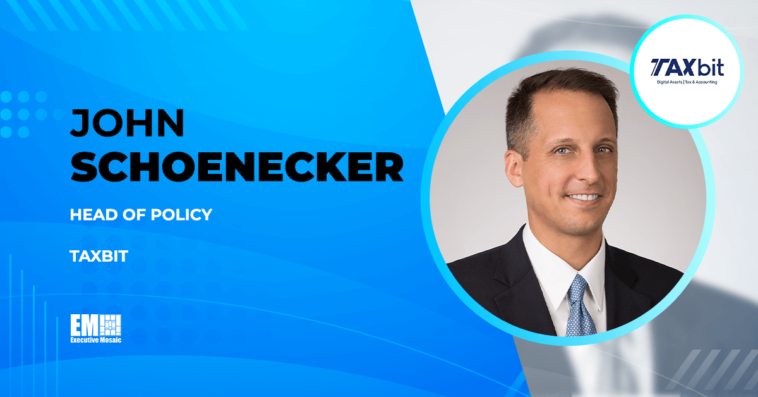The Treasury Department and the Internal Revenue Service released their first set of digital asset tax regulations on June 28, which establishes rules for how brokers must report gains and losses on their customers’ digital asset transactions. TaxBit works at the intersection of industry and government to provide tax and accounting compliance solutions to enterprises and agencies alike, helping them navigate this ever-evolving compliance landscape.
John Schoenecker, head of policy at TaxBit, sat down with ExecutiveBiz to discuss the Treasury’s recently released digital asset tax regulations. In this Spotlight interview, John explains the significance of these regulations in the U.S. policy landscape and how they will affect the digital asset industry as a whole.
ExecutiveBiz: Before we dive into the contents of the Treasury Department’s digital asset regulations, can you please give us an overview of your professional background and role at TaxBit?
John Schoenecker: I joined TaxBit in 2022 and serve as the company’s head of policy, where I lead the company’s engagements with Capitol Hill and the federal government’s executive branch. These connections are an important part of how we service both our public sector and industry customers.
Prior to joining TaxBit, I worked as tax counsel for the House Ways and Means Committee and then for the Senate Committee on Finance. While I was lucky to focus on several tax issues during my time on Capitol Hill, I most enjoyed investigating tax shelters for Sen. Charles Grassley when he served as chair for the Finance Committee. This was a skill I learned as a trial attorney for the Department of Justice’s Tax Division, where I had the pleasure of serving for eight years. You hear government lawyers say this all the time, and it’s true — standing up in federal court and introducing yourself to the judge “on behalf of the United States” was a thrill that never got old and something I took a lot of pride in. These experiences have been invaluable in my current role.
ExecutiveBiz: Now, let’s discuss the Treasury’s recently released digital asset tax regulations. Before we get into specifics, what should we know?
John Schoenecker: These regulations have been years in the making. By the end of the last decade, Treasury had already started drafting regulations for digital asset tax reporting. However, that effort never came to fruition without legislation.
Then, in 2021, Congress passed the Infrastructure Investment and Jobs Act, or IIJA, which included provisions that would require digital asset brokers to track gains and losses incurred on digital asset investments to be reported to the IRS. IIJA was funded through a variety of mechanisms, including the digital asset tax reporting requirements set forth by the bill, which are expected to generate $28 billion in tax revenue.
In response to the provisions outlined in IIJA, Treasury issued proposed regulations on digital asset broker reporting in August 2023. Treasury received over 120,000 comments from industry during a comment period that lasted through mid-November, which culminated in a virtual public hearing. Treasury and the IRS then spent the next seven months finalizing regulations, taking industry feedback into account. On June 28, Treasury released the first set of final regulations, offering clear guidance for proper tax reporting for custodial digital asset brokers.
The IRS also released a draft 1099-DA form this April, which will become the digital asset-specific tax form. The IRS is likely to release the final version of that form soon, which will need to be filed in early 2026 for the 2025 tax year.
ExecutiveBiz: Why are these regulations significant? And how will they now affect the digital asset industry in the United States?
John Schoenecker: These regulations are significant for several reasons. To start, they represent an important first step toward closing the estimated $50 billion digital asset tax gap. Moreover, these regulations could help to further accelerate digital asset adoption. They set clear requirements for the tax information that brokers must provide to customers, making it easier for individuals to understand their tax obligations when filing. Increased tax clarity may encourage those who were previously skeptical to feel more confident when entering the space.
Of course, the regulations’ finalization also means that enterprises in the digital asset industry will need to comply with new requirements, something they should prepare for sooner rather than later, starting with collecting the necessary customer information. In early 2026, brokers will have to report their customers’ gross-proceed information for tax year 2025. A year later and onward, they will have to report cost-basis and gross-proceed information starting with tax year 2026.
ExecutiveBiz: Was there anything that was different in the final version of regulations that wasn’t included in the proposed version released last year?
John Schoenecker: Yes, there were a few notable changes from what was proposed, which should make compliance easier. First of all, there’s a $10,000 floor for reporting certain stablecoin transactions, in addition to new reporting requirements for stablecoins overall. Rather than receiving a new form for each stablecoin transaction, digital asset brokers can report on this asset type in an aggregated manner. There is also a new $600 reporting floor for NFT transactions and for brokers that help merchants accept digital assets for business payments.
Notably, noncustodial brokers such as decentralized exchanges or unhosted wallets will receive their own set of rules for tax compliance, which is expected to be issued by Treasury soon.
ExecutiveBiz: So, what does this all mean for the future of the digital asset industry in the United States?
John Schoenecker: Digital asset tax reporting regulation has been a top agenda item in the world of tax policy for years, so finally seeing these regulations in final form is a big milestone for industry and the tax community. This new guidance will not only help close the digital asset tax gap, but also provide enterprises and individuals in the digital asset space with clear and stable guidance for compliance, contributing to a more legitimate financial market that should hopefully propel further adoption of the asset class.
It’s also worth noting that similar regulatory efforts are taking place in jurisdictions across the globe. For example, DAC 8 in Europe is set to go into effect in the coming years, around the same time as Treasury’s regulations, both of which are aligned with the Organisation for Economic Co-operation and Development’s Crypto Asset Reporting Framework.
These international efforts to properly tax and regulate digital assets represent an important maturation stage for the digital asset industry across the globe. Ultimately, they will help pave the way for further innovation and widespread adoption of the asset class, in the United States and abroad.





